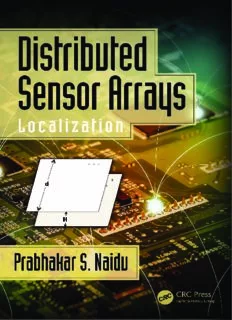Table Of ContentDistributed Sensor Arrays
Localization
Distributed Sensor Arrays
Localization
By
Prabhakar S. Naidu
MATLAB® is a trademark of The MathWorks, Inc. and is used with permission. The MathWorks does not war-
rant the accuracy of the text or exercises in this book. This book’s use or discussion of MATLAB® software or
related products does not constitute endorsement or sponsorship by The MathWorks of a particular pedagogical
approach or particular use of the MATLAB® software.
CRC Press
Taylor & Francis Group
6000 Broken Sound Parkway NW, Suite 300
Boca Raton, FL 33487-2742
© 2018 by Taylor & Francis Group, LLC
CRC Press is an imprint of Taylor & Francis Group, an Informa business
No claim to original U.S. Government works
Printed on acid-free paper
International Standard Book Number-13: 978-1-138-63213-4 (Hardback)
This book contains information obtained from authentic and highly regarded sources. Reasonable efforts have
been made to publish reliable data and information, but the author and publisher cannot assume responsibility
for the validity of all materials or the consequences of their use. The authors and publishers have attempted to
trace the copyright holders of all material reproduced in this publication and apologize to copyright holders if
permission to publish in this form has not been obtained. If any copyright material has not been acknowledged
please write and let us know so we may rectify in any future reprint.
Except as permitted under U.S. Copyright Law, no part of this book may be reprinted, reproduced, transmit-
ted, or utilized in any form by any electronic, mechanical, or other means, now known or hereafter invented,
including photocopying, microfilming, and recording, or in any information storage or retrieval system, with-
out written permission from the publishers.
For permission to photocopy or use material electronically from this work, please access www.copyright.com
(http://www.copyright.com/) or contact the Copyright Clearance Center, Inc. (CCC), 222 Rosewood Drive,
Danvers, MA 01923, 978-750-8400. CCC is a not-for-profit organization that provides licenses and registration
for a variety of users. For organizations that have been granted a photocopy license by the CCC, a separate
system of payment has been arranged.
Trademark Notice: Product or corporate names may be trademarks or registered trademarks, and are used
only for identification and explanation without intent to infringe.
Visit the Taylor & Francis Web site at
http://www.taylorandfrancis.com
and the CRC Press Web site at
http://www.crcpress.com
Dedication
This work is dedicated to the memory of my mentor, the
late Professor B.S. Ramakrishna, who shaped my career
in the Department of Communication Engineering,
Indian Institute of Science, Bangalore, India.
Contents
Preface.......................................................................................................................xi
Acknowledgments ..................................................................................................xiii
Author ......................................................................................................................xv
Chapter 1 Distributed Sensor Arrays ....................................................................1
1.1 Regular Sensor Array ................................................................1
1.2 Wired Sensor Array ...................................................................2
1.2.1 DSA Response ..............................................................3
1.2.2 Focused Beam ..............................................................4
1.2.3 Boundary Array ...........................................................7
1.3 Autonomous Wireless Sensor Network ....................................7
1.3.1 Wireless Sensor Network (WSN) ...............................10
1.4 Types of Sensors ......................................................................12
1.4.1 Thermal Sensor ..........................................................13
1.4.2 Microphone ................................................................14
1.4.3 Hydrophones ...............................................................15
1.4.4 Accelerometer.............................................................16
1.4.5 Electromagnetic (EM) Sensors ..................................19
1.4.6 Electric Sensors ..........................................................19
1.4.7 Magnetic Sensors .......................................................19
1.4.8 Hall Effect ..................................................................20
1.4.9 Nanosensors ...............................................................21
References ..........................................................................................22
Chapter 2 Basic Inputs ........................................................................................23
2.1 Received Signal Strength.........................................................23
2.2 Lighthouse Effect ....................................................................25
2.2.1 Beam Generation ........................................................26
2.2.2 Prototype ....................................................................28
2.2.3 Events with Large Propagation Speed Difference .....28
2.3 Time of Arrival ........................................................................28
2.4 Time Difference of Arrival .....................................................31
2.4.1 TDoA with a Reference Transmitter ..........................32
2.5 Frequency Difference of Arrival .............................................32
2.6 Direction of Arrival ................................................................36
2.7 Phase Change...........................................................................38
2.8 Instantaneous Frequency .........................................................39
2.9 Summary .................................................................................39
References ..........................................................................................40
vii
viii Contents
Chapter 3 Estimation of ToA/TDoA/FDoA .......................................................41
3.1 Generalized Cross-Correlation ................................................41
3.2 Time Delay as FIR Filter .........................................................45
3.3 Eigenvector Approach .............................................................49
3.4 Subspace Approach .................................................................54
3.5 Capon’s Minimum Variance ....................................................57
3.6 Adaptive Notch Filter ..............................................................60
3.6.1 Adaptation Scheme .....................................................64
3.6.2 Delay Estimation ........................................................64
3.7 Instantaneous Frequency Spectrum ........................................67
3.8 Phase-Based Methods ..............................................................69
3.8.1 Multitone Signaling ....................................................71
3.8.2 Sliding FDFT .............................................................73
3.9 Frequency Difference of Arrival .............................................76
3.9.1 Adaptive Frequency Detector .....................................77
3.9.2 Computational Complexity ........................................82
3.10 Summary .................................................................................82
References ..........................................................................................83
Chapter 4 Localization ........................................................................................85
4.1 Received Signal Strength.........................................................85
4.1.1 Transmitter Coordinates .............................................87
4.1.2 Estimation Errors .......................................................90
4.2 ToA Measurements ..................................................................93
4.2.1 Simple Method ...........................................................93
4.2.2 Iterative Method .........................................................94
4.3 TDoA Measurements...............................................................99
4.3.1 Re-Minimization ........................................................99
4.3.2 Treat Range as a Variable .........................................103
4.3.3 Annihilation of Range Variable ...............................105
4.3.4 Direction Cosines .....................................................106
4.4 FDoA Measurements .............................................................108
4.4.1 Differential Doppler .................................................112
4.5 DoA Measurements ...............................................................113
4.5.1 Errors in Node Position ............................................114
4.5.2 Errors in DoA ...........................................................115
4.5.3 Analysis of Bias .......................................................118
4.5.4 Total Least Squares (TLS) .......................................119
4.6 Compressive Sensing .............................................................120
4.6.1 Compressive Sampling Matching Pursuit
(CoSaMP) .....................................................................122
4.6.2 Localization .............................................................123
4.6.3 Far Field ....................................................................123
4.6.4 Near Field .................................................................128
Contents ix
4.6.5 One-Bit Quantized Measurements ..........................130
4.7 Summary ...............................................................................135
References ........................................................................................136
Chapter 5 Hybrid Methods for Localization .....................................................137
5.1 Combined Use of FDoA and TDoA ......................................137
5.1.1 Narrow Band ............................................................137
5.1.2 Annihilating Matrix .................................................139
5.2 Direct Position Determination ...............................................140
5.3 DoA from Distributed Sensors ..............................................145
5.4 Expectation-Maximization Algorithm ..................................156
5.4.1 Expectation Step (E-Step) ........................................158
5.4.2 Maximization Step (M-Step)....................................160
5.4.3 Estimation of Transmitted Signal .............................162
5.5 Localization in a Multipath Environment .............................163
5.5.1 Time Domain ...........................................................163
5.5.2 Frequency Domain ...................................................169
5.6 Summary ...............................................................................173
References ........................................................................................175
Chapter 6 Self-Localization ..............................................................................177
6.1 Anchor-Based Localization ...................................................177
6.1.1 Cooperative Localization .........................................182
6.1.2 Subspace Positioning Approach ...............................184
6.2 Anchor-Free Localization......................................................189
6.2.1 Multidimensional Scaling ........................................189
6.2.2 Basis Point MDS ......................................................194
6.2.3 1D Space ...................................................................195
6.2.4 2D Space...................................................................195
6.2.5 3D Space ...................................................................197
6.2.6 Missing Data ............................................................199
6.2.7 Computational Load .................................................199
6.3 Clock Synchronization ..........................................................200
6.3.1 Single Reply .............................................................201
6.3.2 Double Reply ............................................................202
6.3.3 Linear Model ............................................................203
6.3.4 Joint Estimation of Offset, Skew (Drift), and Delay ....206
6.3.5 Estimation of Travel Time ........................................208
6.4 Summary ...............................................................................211
References ........................................................................................212
Index ......................................................................................................................213
Description:Localization of transmitters and receiving sensors is achieved by measuring radiation emitted by a source to a set of sensors, which are either on a definite pattern, known as an array, or one randomly located at irregular points, known as a distributed sensor array. This book discusses how to dete

